

EAP Publications | Virtual Library | Magazine Rack | Search
Join the Ecological Solutions RoundtableEAP Publication - 29
Stuart B. Hill
Some view ecological or organic farming as the way of the past. I tend to view it as the way of the future. For an increasing number of people, it is the way of the present. For some it is a new technique; and for others, a kind of religion. It is really all of these things: the past, present, and future brought together with a new technology and life-style. It is important that we do not concentrate on just one part of this and that we view it as one aspect of an attempt to establish a life-style for our species that can be permanent within the limitations of geological change.
In defining the problem of this conference, I would like to focus on the soil-food-health chain (Figure 1). I hope that by doing this some of the fundamental differences between current and ecological methods of food production will be clarified.
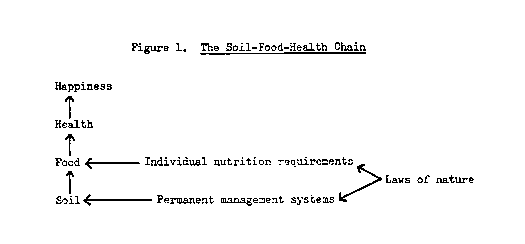
There are two primary needs within this chain:
1. A permanent, self-sustaining system for producing food and fiber. As the present system is dependent on fossil fuels and other nonrenewable resources, it can be only temporary. He have to establish a "post-industrial" agriculture.
2. A way of identifying and satisfying our individual nutritional needs. There is a tendency with mass approaches to everything to work out what the average person needs to be nutritionally satisfied. Because individual needs vary enormously, this is unsatisfactory.
Thus, the establishment of an alternative agriculture is dependent on knowing our specific nutritional needs and knowing how to manage agroecosystems in a permanent way.
Our political and economic systems, by requiring us to examine short-term relationships only, has deluded us into believing that organisms and environments can be forced to conform to artificial and not ecological laws. The tendency for many harmful effects to take a long time to manifest themselves has encouraged this attitude. However, the problems that we now encounter are symptomatic of this approach. Most of the solutions being proposed are developed without consideration for their broader or long-term effects.
The generation of these solutions may be regarded simply as irresponsible dreaming. An amusing example of this was displayed by an uninhibited colleague who remarked at an extravagant luncheon that he was looking forward to the day when science will have advanced to the point where he can have his anus joined to his mouth, and so cut out the middleman.
It is obvious that such an attempt to bypass nature would not solve the food crisis. However, we are indulging in the same sort of dreaming when we imagine we can solve problems of infertile soils, pests, diseases, and deficient foods simply by means of inorganic fertilizers, pesticides, antibiotics, and food supplements. The proposal of these kinds of solutions is symptomatic of a science trapped in the stranglehold of inductive logic and reductionism. Adherence to these approaches is preventing us from dealing with the causes of our problems.
Pests do not arise because of a deficiency of pesticide in the environment any more than headaches result from a lack of aspirin in the blood. We get headaches because of the way in which we conduct our lilts, And we get pests in the fields because of the way we manage them , 18, 29, 48
In addition to the above criticism, solutions to symptoms eventually create problems in other areas. Hence, in order to increase yields, nitrogen fertilizers, synthesized from natural gas, are being applied to our soils in ever-increasing amounts. The side effects of this application include the depletion of natural gas reserves, the contamination of food and water with nitrates (resulting in health and pollution problems), damage to the ozone layer by nitrous oxides, and the accelerated decomposition of soil organic matter. The associated loss of soil structure has led to increased erosion. The use of synthetic inorganic fertilizers has also allowed us to discard food and agricultural wastes rather than returning them to agricultural land as fertilizer. Thus, most food wastes are incinerated, released into bodies of water, or deposited on nonproductive land as landfill, causing air, water, or land pollution.
Father than work within the natural cyclical nutrient flows we have used manpower and resources to establish linear systems. The fact that they function within the framework of our short-term economic view only justifies them economically. Ecologically, linear systems make no sense at all.
Unfortunately, we have allowed powerful bureaucracies to develop that are able only to generate and implement these "specialist (simplistic solutions). Also, it is questionable whether they are even anxious to solve the problems in the long term, as this would deprive them of their power. It is little wonder that alternative lines of research are systematically stifled.
Solutions to symptoms are guaranteed to be addictive and disruptive. While our present system provides the means for generating profit, employment, and political power, it is a treadmill that we must get off it we are to deal with the causes of our problem.
It is important to realize that our survival is dependent not on economic but ecological relationships with the environment. Consequently economic systems must develop around ecological realities. Therefore, in order to establish agricultural policies that can be permanent, we have to recognize
1) the current state of our food system,
2) our needs and the ways in which agriculture can satisfy them, and
3) the laws of nature and the limitations of the environment.
It is a matter of recognizing where we are now, deciding where we want to go, and finding out how we are going to get there.
Our present "production for profit" food system has evolved from one in which production was for "use" In striving to survive economically, agriculture has had to increase production per area and per farmer. This has led not only to an increased dependence on non-renewable resources but it has also become a threat to its renewable resource base, and to human health. The farmer is unfortunately in a weak position. He has little control over costs of his outputs and no control over his inputs he is unfairly taxed and is continually having to run to the bank manager to bail himself out. Few other sectors of society are so vulnerable. Consequently, it is unlikely that the farmer will be able to correct this situation alone.
It is our view that this state of affairs has already led to a loss of food Quality. The ways in which the nutritional quality of plant materials might be decreased are illustrated in Figure 2. This deductive mod, is based on the concept of Roger Williams 5, that the body can only suffer from two nutritional problems -- lack of certain required nutrients (malnutrition) and the presence of toxins (poisoning). The model asks how our various food production and handling practices might affect the nutritional and toxic status of the food currently available.
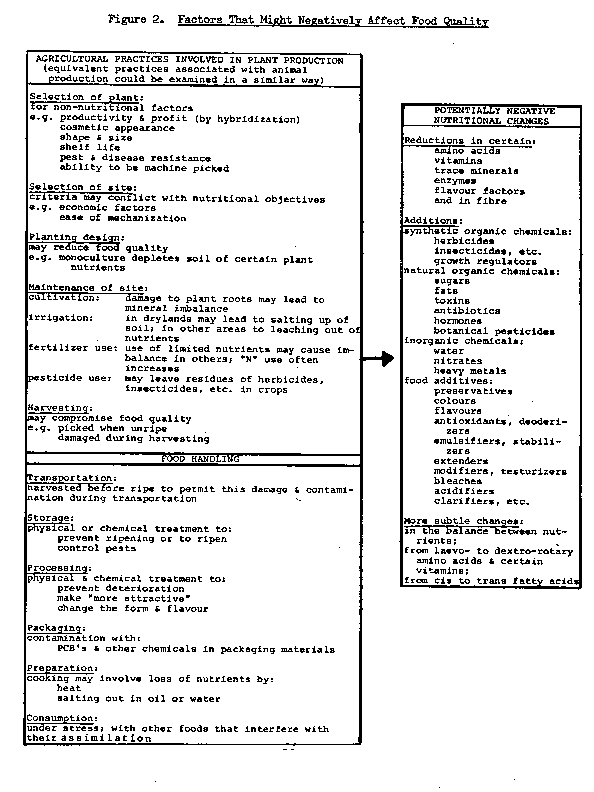
This is particularly important because our nutritional requirements have increased, partly as a result of exposure to the growing number of poisons in the environment 35, 47 that require detoxification. Thus, we have a greater need for high-quality food that cannot be satisfied by current agricultural practices. Ironically, the system that should supply us with this food is, instead, contaminating it with poisons and decreasing its nutrient content.
The increase in degenerative diseases in the developed world, and in the less developed areas under the influence of the former , should not come as a surprise. Degeneration is the consequence of genetic predisposition, malnutrition, toxification (through air, water, and food) 10, 24, lack of exercise, stress, and inadequate relaxation (Figure 3). This makes common sense, yet the dominant approaches being taken to deal with degenerative diseases include the search for causative organisms, the physical or chemical destruction of degenerative tissues (remember that the surgeon reigns supreme within the medical profession), and the masking of the situation with pain killing drugs. This tendency to deal with symptoms rather than with causes, which is equally prevalent in medicine and agriculture, has become the major degenerative disease of science.
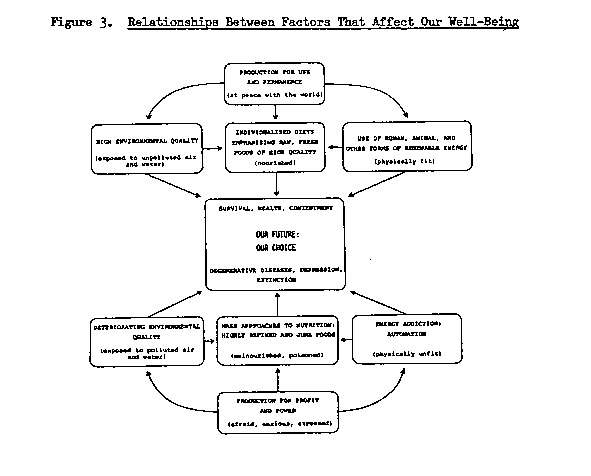
Thus, we consider that the prevention of degenerative diseases will require not just medical approaches, but the combined efforts of agriculturalists, nutritionists, geneticists, environmental scientists, clinical ecologists, and experts concerned with physical and mental health.
To survive in a healthy, contented state, we essentially have to develop a symbiotic relationship with our support environment. This requires that we identify our real needs 10, 24 and the ability of the environment to satisfy them. Economists frequently distinguish between "real needs" (basic food, shelter, and clothing) and "manipulated or non-essential wants" (many of which we strive for to lift us above our fellows). All too often "real needs" are sacrificed for the latter.
The food industry has had to manipulate our eating habits in order to dispose of the surpluses generated by our highly specialized and "efficient" production system. Thus, more money is now spent on foods such as corn, wheat, and potatoes in their highly processed and nutritionally inferior forms (e.g., corn flakes, cookies, and potato chips) than in their more valuable elemental stately. The processing industry, through the clever use of advertising, has become so successful that it now dominates the food system l7, 28; and agriculture has been relegated to the position of merely supplying the raw materials. Hence, agriculture now caters largely to "manipulated wants".
Unless we change our myopic view of efficiency, we are misleading ourselves in believing that a more "efficient" agricultural system is the -panacea for the food and energy crisis. Changes in policy will result in "real" progress only if such increases in efficiency are concerned with the production and fair distribution of items that we really need.
In considering this subject, we have repeatedly felt that the problems identified above are obvious. And yet they have not been able to stimulate any real attempt to deal with them at the causal level. Why do most people find it so difficult to deal with these problems? There appear to be three reasons for this.
First, we have become so adapted to the present situation that we find it difficult to view ourselves objectively. The tendency to defend the status quo and to recognize problems as being apart from ourselves provides evidence of this.
Second, the information explosion and expanding scale of production have forced people to specialize. The increase in inductive and reductionist approaches in science and the tendency to deal with symptoms rather than causes (as discussed above) are associated with this. In this way it has become increasingly difficult for people to comprehend the complex realities of nature.
Third, most religions and political ideologies tend to separate us from the support environment, e.g., our "dominion over nature" 44. This has been considerably reinforced over the past hundred years by our use of fossil fuels to free ourselves from the constraints that dominated the lives of our ancestors. For example, when it is hot we tend to seek places that are air-conditioned; we no longer know where the naturally cool areas are within the environment.
To counteract these problems we must make a conscious effort to examine ourselves objectively, comprehensively, and in relation to the support environment. One way to do this is to ask questions of ourselves that an ecologist would ask when studying other organisms: How many are there? For us how many is optimum? How are they distributed? How should and shouldn't we distribute ourselves? What are they doing? What should and shouldn't we do? The relationships among these three variables and the support environment are shown in Figure 4.
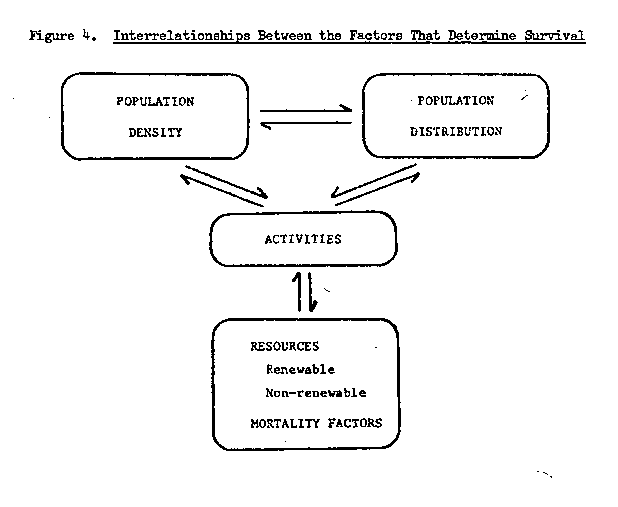
Many people concerned with the food crisis tend to regard it as a population problem. However, we cannot expect to solve our problems by reducing population growth if some or all members of the remaining population continue to distribute themselves out of context with the environment or indulge in activities that are a threat to survival.
In deciding what we should and should not do, it is useful to consider the following four "laws of natured, 8, 9. All species, including our own, are subject to these laws. The fact that we have been able to follow a '[live now pay later" philosophy for so long should not be taken as evidence to the contrary. The Earth has an enormous amount of capital in the form of fossil fuels and other non-renewable resources, soil fertility, and ecosystem stability (evolved over millions of years through increased complexity). We have developed a life-style dependent on the exploitation of this capital 31. It is understandable that people are not willing to sacrifice those activities and life-styles supported by these resources; and hence, that they become defensive when it is suggested they will have to reduce this dependence.
The first law of nature is that survival for any species, whether it is a plant, animal, or microorganism, is dependent on needs, the availability of what is needed, and on various mortality factors. If we examine our current food system we find that it contravenes this law at every stage. We are producing many things we do not need. The system is based on non-renewable resources; and some of the technologies we employ are lethal or sub-lethal, e.g., injuries by machinery and poisoning by toxic chemicals. The implications for policymakers are that they support efforts to distinguish between real needs and manipulated wants and establish a safe food system based on renewable resources.
The second law is that relationships are cyclical. Modern agriculture is characterized by linear nutrient flows. Thus we produce fertilizer to feed plants, to feed animals, to feed people, and in the process, to pollute rivers. It is essential that we abandon this practice and develop cyclical systems. For instance, natural organic waste materials should be returned to the land as fertilizer.
The third law is that all natural ecosystems become more complex with time. Complex systems develop naturally by means of energy from the sun. It is ironic that we have developed a food system based on simplifying the biological components of the environment by means of a technology of increasing complexity. The farmer needs to know less and less about biology and more and more about engineering, chemistry, and economics. In trying to keep the agro-ecosystem simple, we are essentially using fossil fuel in opposition to the energy from the sun. Clearly we must learn to manage complex biological systems, an example of which is intercropping.
The fourth law is that there are various biochemical constraints that apply to all life. For example, there are many compounds which do not exist in living organisms. Consequently, the decomposers that break down dead organisms have adapted to a very restricted diet. Thus if organic compounds are produced that have no counterpart in nature, they will not likely break down biologically. We must establish a life-style that relies only on those organic materials that have a counterpart in nature and ban or severely restrict the production of other organic chemicals.
The laws of nature know no compromise. They are constant, at least within the framework of human history, and the sooner our species becomes aware of these laws and establishes political, social,' and economic systems that are consequential upon them, the sooner we will be able to move toward real solutions to our problems.
Our preliminary views of what a permanent food system might involve are presented in Figure 5 14,21,26,27,37,43,46 . In designing this system we have taken the above constraints into consideration. The difference between our system and the present food system may be seen most clearly by comparing Figures 5 and 6.
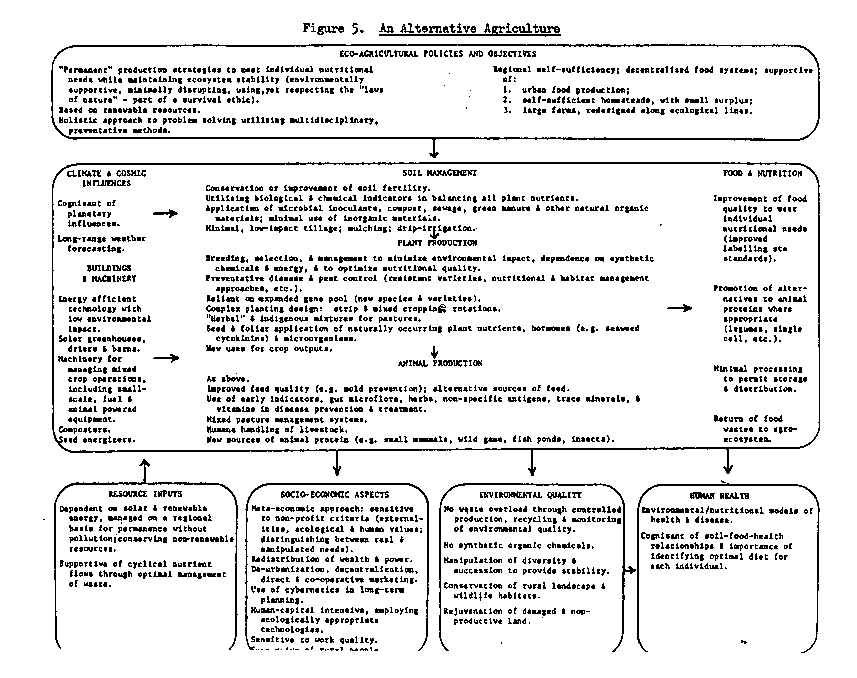
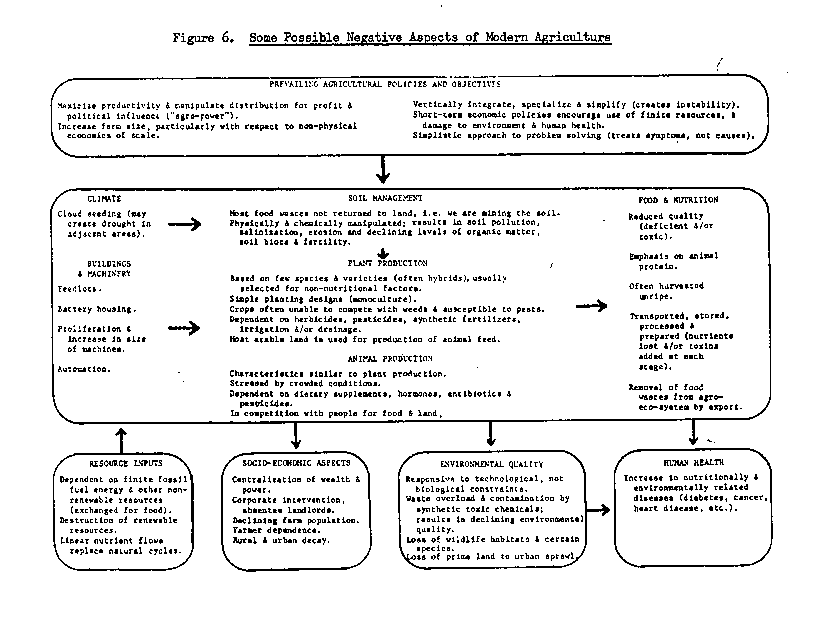
The only group of producers currently attempting to utilize a significant number of these approaches are the ''organist farmers. Despite the findings of the Center for the Biology of Natural Systems 22, 23, many agriculturalists still maintain that the people of the world could not be fed by employing these methods 5, 12. A number of years ago Dr. O. V. Grussendorf 15 of Manitoba set out to prove that this was not so. He selected a piece of land declared completely unfit for agriculture. In fact, it was so unfit that he purchased it for one dollar an acre. He established a mixed farm, composted his waste biodynamically 39, and applied it to his land, while importing no fertilizers, pesticides, or other materials into the system. In 1968 he produced 1000 bushels of potatoes an acre and JO bushels of top quality wheat. The average for Canada at that time was 168 and 22 bushels, respectively.
It is our opinion that we could learn much by studying the methods of such people as Dr. Grussendorf, for they are doing what many conventional agriculturalists regard as impossible 5. Their efficient use of energy represents only one feature of the system they are employing. (Several other successful "organic" farmers are interviewed in Christopher Chapman's recent film for the National Film Board of Canada entitled "A Sense of Humus n, 1976).
Currently our food system is designed to produce food that can be sold rather than food that meets real needs. It is imperative that we establish
1) systems for producing food (and fiber) that can be permanent" and
2) ways for identifying each individual's nutritional needs.
As both of these are determined by the laws of nature, it essential that we become aware of those laws.
Many changes will be required if we are to develop a viable alternative food system. Even though energy studies have revealed several weaknesses within the present system, far-reaching political and socioeconomic changes will be needed in order to create an environment in which those involved can respond to these findings. This situation will similarly prevent people from adequately responding to the findings of any other studies of the food system.
Consequently, scientists are naive if they expect that the required changes will necessarily follow high quality research. One potentially serious weakness within our food system (to which energy studies have not addressed themselves) is that food quality maybe compromised at every stage within the food chain. Unless attention is paid to this situation, we predict we will experience further increases in the incidence of degenerative diseases. Indeed, this situation already may be further advanced then we suspect.
We are encouraged, however, by the recent food and nutrition policies implemented by the Norwegian government . They have established models of consumption based on health and resource considerations and have proceeded to implement policies that will lead to changes in production and eating habits. For example, the price of range fed beef, which contains less saturated fat then feedlot beef, has been reduced below that of the latter. They expect, among other things, that this will help reduce the incidence of heart disease.
It is our hope that other countries will soon examine their food systems and make the necessary changes in policy.
1. Albrecht, W. A. 1975. The Albrecht Papers. 515 pp. Acres, U.S.A. Raytown, Missouri, USA.
2.Balfour, Lady Eve B. 1975. The Living Soil and the Haughly Experiment. 383 pp. Faber & Faber, London, England.
3. Bicknell, F. 1960. Chemicals in Food and in Farm Produce: Their Harmful Effects. 192 pp. Faber ~ Faber, London, England.
4. Blythe, C. 1976. "Eating Your Nay Out of Debt and Diseases. New Scientist 70 (939): 278-280.
5. Butz, E. 1972. "Meet the Press (N.B.C.)" p. 123. In: A. F. and J. R. Pater (editors). What They Said in 1971: The Yearbook of Spoken Opinion. Monitor Book Co., Beverly Hills, California, USA.
6. Cairns, J. 1975. "The Cancer Problem". Scientific American 233 (5): 64-78.
7. Commoner, B. 1970. "The Ecological Facts of Life". pp. 18-35. In: H. D. Johnson (editor). No Deposit = No Return: Man and His Environment: A View Toward Survival. 351 pp. Addison-Wesley, Don Mills, Ontario, Canada.
8. Commoner, B. 1971. The Closing Circle: Mane Nature and Technology. 262 pp. Bantam Books, New York, New York, USA.
9. Dansereau, P. 1966. "Ecological Impact and Human Ecology". pp. 425462. In: F. F. Darling and J. F. Milton (editors). Future Environments of North America. 770 pp. Natural History Press, Garden City, New York, USA.
10.Dickey, L. D. (editor). 1976. Clinical Ecology. 807 pp. Charles C Thomas, Springfield, Illinois, USA. '
11. Epstein, S. S. and R. D. Grundy (editors). 1974. Consumer Health and Product Hazards of Cosmetics and Drugs. Pesticides, Food Additives .Vol. 2 of The Legislation of Product Safety. M.I.T. Press, Cambridge, Massachusetts, USA.
12. Gavett, E. E. 1975. "Can 1918 Farming Feed 1975 People?'t. Farm Index 13 (8): 10-13.
13. Gilbert, F. A. 1957. Mineral Nutrition and the Balance of Life. 350 pp. University of Oklahoma Press, Norman, Oklahoma, USA.
14. Goldnmith, E., R. Allen, M. Allaby, J. Davol, and S. Lawrence. 1972. A Blueprint for Survival. 139 pp. Penguin Books, Harmondsworth, Middlesex, England.
15. Grussendorf, O. W. 1969. "Here's the Evidence". Land Bulletin 146:
16. Hall R. H. 1974. Food for Nought: The Decline in Nutrition. 292 pp. Vintage Books, Random House, New York, New York, USA.
17.Hightower, J. 1975. Eat Your Heart Out: Food Profiteering in America. 294 pp. Crown Press, New York, New York, USA.
18. Hill, S.B. (In press). "Preventative Pest Control". Alternatives.
19. Howard, Sir Albert. 1947. The Soil and Health: A Study of Organic Agriculture. 307 pp. Schoken Books, New York, New York, USA.
20. Hunter, B. T. Food Additives and Federal Policy: The Mirage of Safety. 322 pp. Chas. Scribner's Sons, New York, New York, USA.
21. Lappe, F. M., J. Collins, and C. Fowler. (In press). Food First. Institute for Food Development Policy, Hastings-on-Hudson, New York, USA.
22. Lockeretz, W., R. Keppler, B. Commoner, M. Gertler, S. Fast, D. O'Leary, and R. Blobaum. 1975. "A Comparison of the Production, Economic Returns, and Energy Intensiveness of Corn Belt Farms That Do and Do Not Use Inorganic Fertilizers and Pesticides." Report CBNS-AE-4, 62 pp. Center for the Biology of Natural Systems, Washington University, St. Louis, Missouri, USA.
23. Lockeretz, V., R. Klepper, B. Commoner, M. Gertler, S. Fast, and D. O'Leary. 1976. "Organic and Conventional Crop Production in the Corn Belt: A Comparison of Economic Performance and Energy Use for Selected Farms". Report CBNS-AE-7, 42 pp. Center for the Biology of Natural Systems, Washington University, St. Louis, Missouri, USA.
24. MacKarness, R. 1975. Not All In the Mind. 159 pp. Pan Books, London, England.
25. McCarrison, Sir Robert. 1961. Nutrition and Health. Faber & Faber, London, England.
26. Merrill, R. 1974. "Toward a Self-Sustaining Agricultures. J. New Alchemists 2: 44-61.
27.'Merrill, R. (editor). (In press). Radical Agriculture. Harper & Row, New York, New York, USA.
28. Mitchell, D. 1975. The Politics of Food. 235 pp. James Lorimer & Co., Toronto, Canada.
29. Moore, N. W. 1967. "A Synopsis of the Pesticide Problem". Adv. Ecol. Res. 4: 75-129.
30. Mount, J. L. 1975. F and Health of Western Man. 270 pp. Charles Knoght & Co., London, England.
31. 0dum, H. T. 1970. Environment, Power, and Society. New York, New York, USA.
32. Picton, L. J. 1946. Nutrition and the Soil. 265 pp. Devin-Adair, Old Greenwich, Connecticut, USA.
33. Pirie, N. W. 1972. "The Direction of Beneficial Change". Ecol. Food Nutr. 1: 279-294.
34. Price, W. A. 1945. Nutrition and Physical Degeneration. 526 pp. Price-Pottenger Nutrition Foundation, Santa Monica, California, USA.
35. Randolph, T. G. 1962. Human Ecology and Susceptibility to the Chemical Environment. 148 pp. Charles C Thomas, Springfield, Illinois, USA.
36. Schroeder, H. A. 1974. The Poisons Around Us: Toxic Metals in Food. Air, and Water. 144 pp. Indiana University Press, Bloomington, Indiana, USA. -
37. Schumacher, E. F. 1974. Sm~11 Is Beautiful: Economics as if People Mattered. 255 pp. Abacus, London, England.
38. Shertz, L. P. 1972. World Food Needs". Ecol. Food Nutr. 1: 207-212.
39. Steiner, R. 1958. Agriculture. 175 pp. Bio-Dynamic Agricultural Association, London, England.
40. Turner, J. S. 1970. The Chemical Feast: The Ralph Nader Study Group Report on Food Protection and the Food and Drug Administration. 273 pp. Grossman Publishers, New York, New York, USA.
41. Verrett, J., and J. Carper. 1974. Eating May Be Hazardous to Your Health How Your Government Fails to Protect You from the Dangers in Your Food. 255 pp. Simon & Schuster, New York, New York, USA.
42. Voisin, A. 1959. Soil, Grass, and Cancer: Health of Animals and Men Is Linked to the Mineral Balance of the Soil. 302 pp. Crosby Lockwood, London, England.
43. Walters, C. 1975. T Case for Eco-Agriculture. 122 pp. Acres, U.S.A., Raytown, Missouri, USA.
44. White, L. 1967. "The Historical Roots of Our Ecologic Crisis". Science 155 (3767): 1203-1207.
45. Williams, R. E. 1971 Nutrition Against Disease: Environmental Prevention. 370 pp. Pitman Publishing Corp., New York, New York, USA.
46. Wolf, W. (editor). 1975. Organic Farming: Yearbook of Agriculture. 96 pp. Rodale Press, Emmaus, Pennsylvania, USA.
47. World Health Organization. 1972. Health Hazards of the Human Environment. 387 pp. WHO, Geneva, Switzerland.
48. Yarwood, C. E. 1970. Man-made Plant Diseases". Science 168: 218-220.
Copyright © 1977
Info Request | Services | Become EAP Member | Site Map
Give us your comments about the EAP site
Ecological Agriculture Projects, McGill University (Macdonald
Campus)
Ste-Anne-de-Bellevue, QC, H9X 3V9 Canada
Telephone:
(514)-398-7771
Fax:
(514)-398-7621
Email: eapinfo@macdonald.mcgill.ca
To report problems or otherwise comment on the structure of this site, send mail to the Webmaster